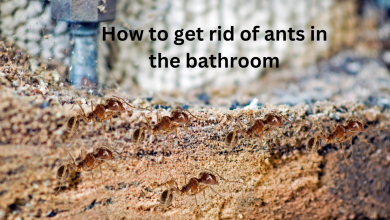Wood borers are insects that can cause significant damage to wood. The most effective way to get rid of them is by using chemical insecticides, such as bifenthrin or permethrin. These chemicals should be sprayed directly onto the affected area and then left for a few days before being wiped off with a clean rag.
Additionally, it’s important to ensure that all crevices and cracks in the wood are sealed up tightly so no more wood borers can enter. Finally, if you want to prevent a future infestation of wood borers, make sure to keep your furniture away from damp areas and regularly inspect any exposed wooden structures for signs of pests.
How to Get Rid of Borer and Protect Wood from Borer Damage
- Step 1: Identify the wood borer infestation
- Wood borers are easily identified by small holes in the wood surface and sawdust-like “frass” that accumulates around them
- Step 2: Determine if treatment is necessary
- If only a few isolated areas have been affected, removal of the infected wood may be enough to control the problem
- Step 3: Treat with an insecticide specifically designed for wood borers, such as cypermethrin or permethrin
- Follow all directions on packaging carefully and wear protective clothing when applying pesticide products
- Step 4: Vacuum up any remaining frass from affected areas after treatment has been applied to get rid of any remaining larvae or eggs which can hatch into adults later on and start another infestation cycle
- Step 5: Seal up any damaged surfaces with paint or varnish to prevent further damage caused by adult beetles emerging from their pupal stage inside the wood itself
How to Get Rid of Wood Borer Naturally
One way to get rid of wood borers naturally is by using a mixture of neem oil and water. Neem oil has natural insecticidal properties that can be used to kill the larvae and adult beetles, preventing them from laying more eggs or causing further damage. To make a neem solution, mix 1 tablespoon of pure neem oil with 1 quart (1 liter) of warm water in a spray bottle, then spray directly onto affected areas as needed.
For best results, reapply every few weeks until all wood borers have been eliminated.
How to Get Rid of Wood Borers Naturally
Wood borers are a common pest of wood furniture and structures, but luckily there are some natural methods to get rid of them. To prevent wood borers from attacking your furniture or structure, you should regularly inspect the wood for signs of damage such as holes or sawdust. If you already have an infestation, try placing sticky traps around the affected area to catch any adult beetles.
You can also use insecticides containing boric acid or neem oil to kill the larvae and adults. Finally, keeping the area clean by vacuuming often and removing debris will help reduce future infestations.
How to Get Rid of Wood Borers Home Remedies
If you have wood borers in your home, there are a few home remedies that can help get rid of them. One option is to use boric acid, which should be applied directly to the infested areas and allowed to sit for several days. You can also try spraying the area with neem oil or insecticidal soap, both of which will kill any larvae present while repelling future infestations.
Finally, keeping humidity levels low and regularly cleaning out any debris from crevices in your walls can also help prevent further infestations by making it difficult for wood borers to thrive in your home.
Wood Borer Treatment Spray
Wood borer treatment spray is a great way to protect wood surfaces from damage caused by wood boring insects. It is applied directly to the surface of the wood, creating an invisible barrier that effectively repels and kills any borers present in the area. This type of spray may also be used on furniture, decks, fences, and other wooden structures for added protection against pests.
Wood Borer Vs Termite
Wood borers and termites are both pests that can damage wood in homes, buildings, and other structures. While the two insects may look similar at first glance, they actually have distinct differences. Wood borers typically attack recently dead or weakened trees, while termites feed on cellulose found in living plants as well as dead plant material.
Furthermore, wood borers create tunnels through the wood they eat while termites create galleries within the wood. Additionally, unlike termite infestations which require a professional exterminator to eliminate them completely due to their highly organized colonies; wood borers are relatively easy to control through simple treatments such as caulking cracks or treating with insecticides.
What is the Best Remedy against Borers?
Borers are a common problem in gardens and plants, but luckily there is an effective remedy to help manage them. The best way to prevent borers from attacking your plants is by using cultural control methods such as examining the soil for signs of borer activity, keeping weeds under control and removing dead or diseased plant material. Additionally, you can use insecticides like carbaryl or permethrin when necessary to target adult borers.
Another option for controlling borer larvae is biological controls such as beneficial nematodes which feed on borer eggs and larvae. Finally, be sure that any affected trees have good drainage so they don’t become overly wet due to standing water which attracts adult borers looking for moist areas where they can lay their eggs. With these preventive measures in place along with regular monitoring of your garden and plants, you should be able to keep borers at bay!
Is It Hard to Get Rid of Borer?
Getting rid of borer can be a challenging task, especially if the infestation is severe. Borers are small insects that tunnel into wood and attack furniture, trees, shrubs and other wooden structures. They feed on the sapwood of the tree or plant, leaving behind sawdust-like frass (excrement) as evidence of their presence.
If left untreated for too long, borer larvae can cause serious damage to your property. The best way to get rid of borers is by using chemical treatments such as insecticides or nematodes that target the adult forms of these pests. Another option is to physically remove them from affected areas with a sharp tool like a knife or chisel; however this approach requires caution since it may not always be effective in eliminating all borer populations from an area.
Additionally, before attempting any type of treatment you should always consult an experienced professional who has knowledge about controlling borer infestations in order to ensure proper application and safety measures are taken during application process.
What Attracts Wood Borers?
Wood borers are insects that feed on and damage wood. They usually enter through cracks in the surface of wooden structures, such as furniture, buildings or even trees. The most common type of wood borer is the beetle, which lays its eggs on the surface of the wood.
When these eggs hatch into larvae they burrow into the wood to feed and grow before emerging as adults.
Pest control is very important in a commercial kitchen. Wood borers can cause extensive damage to timber if left untreated so it is important to identify them early and take action quickly. The main attractants for wood borers are decaying organic matter (such as mold or fungi) found in damp areas of wooden materials, making damp conditions ideal for their development.
Additionally, softwood trees tend to be more attractive than hardwoods due to their softer fibers being easier for beetles and other types of borers penetrate with their mandibles.
What is the Best Spray for Wood Borers?
When it comes to protecting wood from borers, the best spray for wood borers is Bora-Care. This product has been specifically designed to protect against an array of common pests, including termites and carpenter ants. It not only kills existing infestations but also prevents them from returning in the future.
Bora-Care works by creating a protective barrier around the
wood that stops borer insects from entering or exiting while also killing any insect larvae on contact. Additionally, it helps to prevent fungal decay and rot caused by moisture damage which can affect wooden structures over time. Its active ingredients are Boron and Glycols which are proven effective yet safe for humans and pets when used as directed, making it ideal for use in residential spaces without posing any health risks.
With its long lasting results, this easy-to-use once per year application will provide reliable protection for your home’s wooden surfaces all year round!
Conclusion
In conclusion, wood borers can be a nuisance and cause costly damage to wooden furniture and structures. To successfully get rid of wood borers, it is important to identify the type of borer you are dealing with and then use the appropriate pest control methods such as chemical treatments or physical removal techniques. Additionally, preventive measures should also be taken by inspecting new furniture for signs of infestation before bringing into your home or property.
Read Also:
Fornez.com




